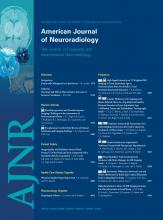Abstract
BACKGROUND AND PURPOSE: Recently some series have been published about the use of Onyx for the treatment of DAFVs with satisfactory results. Our aim was to describe the treatment of different types of intracranial DAVFs with transcatheter injection of Onyx through an arterial approach.
MATERIALS AND METHODS: At the Department of Interventional Neuroradiology, Hospital Lariboisière Paris, between January 2005 and January 2010, we treated 44 DAVFs in 42 patients. All patients were initially treated by arterial injection of Onyx. The average patient age was 56 years (range, 27–86 years), and there were 17 women and 25 men treated.
RESULTS: A total of 58 arterial pedicles were catheterized, with the middle meningeal artery representing the most common site (n = 38). The average time of injection was 30 minutes (range, 15–60 minutes), and the average amount of Onyx was 2.5 mL (range, 0.6–6.5 mL). Of the 20 fistulas with direct venous drainage into a dural sinus (types I and II), we achieved the preservation of the sinus in 7 patients. Of the 44 fistulas embolized, 8 required a second embolization treatment and 1 fistula required a third treatment. In 9 cases, a complementary treatment was performed via transvenous embolization with coils and/or open surgery. Early complications were observed in 6 patients: Four had nerve injury (facial palsy, n = 2, and neuralgia, n = 2), and 2 had complications related to extension of venous thrombosis postembolization. All 6 patients had partial or complete resolution of these symptoms.
CONCLUSIONs: The treatment of DAVFs by intracranial arterial injection of Onyx is safe, and, in most cases, results in the occlusion of the arterial venous shunt. In DAVFs with direct sinus drainage, sinus preservation was only possible in 7 of 20 patients (35%).
ABBREVIATIONS
- CVR
- cortical venous reflux
- DAVF
- dural arteriovenous fistula
- DMSO
- dimethyl-sulfoxide
- Onyx LES
- Onyx Liquid Embolic System
- © 2011 by American Journal of Neuroradiology







